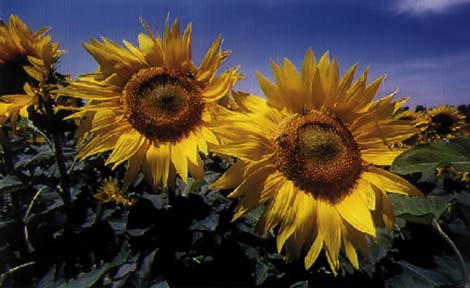
300 pounds is not that cheap for a printer, but it is cheap for the technology Fargo uses: dye diffusion thermal transfer. This is the same technology used in larger format printers costing over ten times as much made by companies like Kodak, Mitsubishi and Tektronix.
The FotoFun's secret is its small print size, a maximum of 6 x 4 inches. This keeps the print head small, and allows the host computer to render the image, saving on electronics.
The final prints have a pleasant, glossy feel and could easily be given to a client as proofs. Saturation is good, although blacks are not quite solid, and prints are faithful to the original colours.

A JPEG file from David Kilpatrick's folio on the Photon site

A Nikon ScanTouch scan of the FotoFun print made from this JPEG (14Kb image) by Stephen Pritchard after downloading it via Netscape
The resolution is less good, and makes text, such as captions, slightly soft. The strong dot pattern visible in prints from Fargo Primera, the 10 x 8 format photo-realistic printer which first broke the 'home use' price barrier, is however not present. The prints are much closer to Kodak in the smoothness of their tones and the absence of a visible pixel pattern. A 6 x 4" print from FotoFun looks much better than a similar sized print from the Primera. It is also laminate coated to prevent fading, something otherwise only available from Kodak in their 8600PS at twenty times the price.
Set-up for the Macintosh is easy, although there is no support for networking. This is unfortunate, as Apple's built-in LocalTalk supports multiple printers and multiple Macs on a low-cost network. But very few dye-sub printers have networking unless they have PostScript, and PostScript isn't needed for image printing.
Another minor inconvenience is the manual-only paper feed. This means siting the printer near the computer - fortunately, it's small - but it makes a run of prints a laborious task. Printing itself was quick using a Power Mac with 16mb of memory.
It's hard to say whether the FotoFun is a useful tool for professional photographers. The 6 x 4" prints are too small for use as final artwork or for display. As proofs, they are neat, but only for stand-alone images rather than full-page or full-screen layouts.
It is an expensive device to run compared to typical 5.99 (pounds) a roll d & p costs. Each 36-exposure print and dye ribbon pack is 39 pounds plus 17.5 percent VAT in Britain, although this may be less by mail order. In comparison, instant Polaroid prints from slides only need a printer costing around 100-200 pounds and have a similar price per sheet; a dye-sub 6 x 4" video printer normally costs around 500-1,000 pounds, and the materials are around the same price unless you buy in bulk.
A high-volume user would be better with a colour laser printer, because although these cost around 5,000 pounds they are much cheaper to run at around 20-30 pence per A4 sheet. For promotional instant photography, there are faster, high volume products. But for the home, or to explore digital imaging, the Fargo cannot bettered: nothing else produces prints of this quality at this cost.